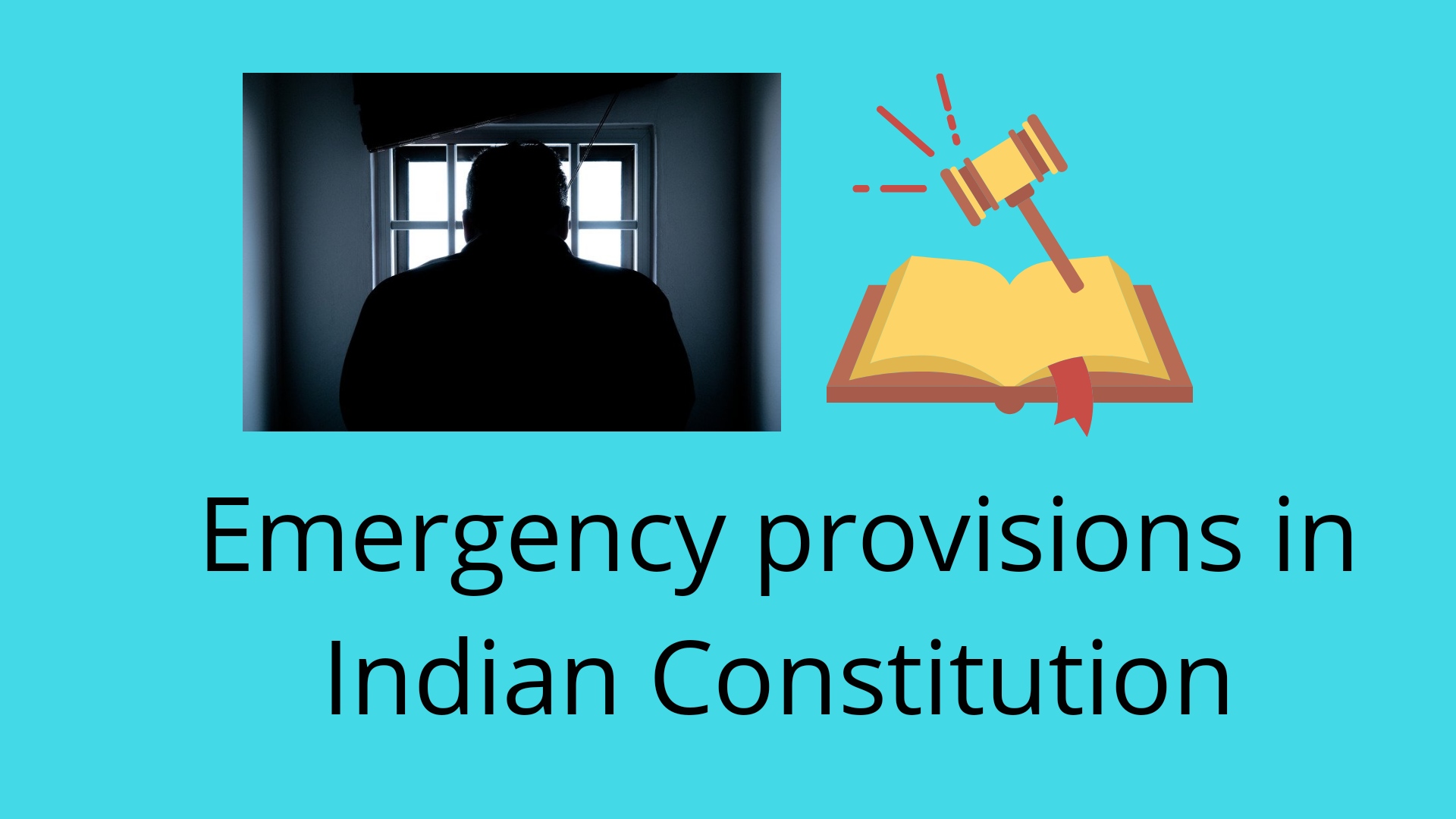
Emergency Provisions under the Constitution of India
- GROUNDS FOR THE PROCLAMATION OF EMERGENCY
- 44TH CONSTITUTIONAL (AMENDMENT) ACT, 1978
- EMERGENCY IN INDIA
- STATE EMERGENCY
- CONCLUSION
From Emergency provisions in Indian Constitution one can easily say India is a federal country of “its own kind”. It acquires unitary features during an Emergency. Due to this reason, Dr B.R Ambedkar called the Indian Federal system as unique because it becomes entirely unitary during an Emergency.
The Indian system of government is of quasi-judicial nature where resembling a federal government, powers are distributed between the centre and the state and similar to unitary form because of retention of powers to the Union during emergency.
According to the Black Law’s Dictionary, “Emergency is a situation which requires quick action and immediate notice as such a situation causes a threat to the life and property in the nation.
It is a failure of the social system to deliver reasonable conditions of life.” 1
Part XVIII of the Constitution consists of emergency provisions i.e. Articles 352 to 360. The power of imposing all three types of Emergencies is vested upon the President of India.
The concept of Emergency was borrowed from the Weimar Constitution of Germany. The three types are as follows:
- National Emergency – Article 352.
- Emergency due to failure of constitutional machinery in states – Article 356.
- Financial Emergency – Article 360.
GROUNDS FOR THE PROCLAMATION OF EMERGENCY:
- National Emergency: Article 352 provides three grounds for proclamation of national emergency i.e., War, External Aggression, and Armed Rebellion 2
- War– When a country declares a formal war against India and there is a violent struggle using armed forces, the President of India may impose National emergency.
- External Aggression – When a country attacks another country without any formal declaration of war. It is a unilateral attack by any country towards India. In such circumstances, the President of India may impose a National emergency.
- Armed Rebellion – Emergency due to the armed rebellion may be imposed by the President of India when a group of people rebel against the present government which will lead to the destruction of lives and property.
- State Emergency: Grounds for the Proclamation of the State Emergency is a failure in the Constitutional machinery of the state. In this Emergency, when Governor of the state is satisfied that the State is not functioning in accordance with the Constitutional provisions then he may write his report to the President of India. And the President, if satisfied by the report, may impose the President’s rule. After that, the President will become the executive head of the state.
- Financial Emergency: Grounds for the Proclamation of the Financial Emergency is that when a state arises in the Country which leads to a financial crisis in India, the President of India may impose emergency to tackle the situation. In this situation, the Central Authority may reduce the budget or cut the budget given to the State, salaries of the Government officials may be deducted.
44TH CONSTITUTIONAL (AMENDMENT) ACT, 1978
The case Indira Nehru Gandhi v Shri. Raj Narain & Anr. 3 ,the validity of election of Mrs. Indira Gandhi was challenged by Raj Narain, a contender against Indira Gandhi.
The court held that the she misused the Government Machinery under Sec. 123(7) 4and was barred from contest of elections for six years.
In furtherance, a national emergency was declared on the ground of “internal disturbance” under Article 352 This led to the 44th Constitutional Amendment (Act), 1978. 5
EMERGENCY IN INDIA
The President of India has power to declare emergency in India or any other part of India making a proclamation.
Under Article 352, if the President is satisfied that a grave emergency exists in India due to which there is a threat to the security of the nation, he may declare Emergency on the grounds abovementioned.
The proclamation of emergency made may be subjected to the judicial review and it does constitutionally can be questioned in a court of law on the grounds of malafide.
The proclamation made must be approved by both the houses of parliament within one month after the proclamation. The effect of the proclamation of emergency is the emergence of the full-fledged Unitary Government.
Under Article 358, National Emergency suspends the rights guaranteed under Article 19 of the Indian Constitution. Also, other Fundamental Rights get suspended under Article 359 except Article 20 and 21.
In India, National Emergency has been imposed three times so far between the period from 1962-1977.
The First Emergency was imposed at the time of Indo-China war by the then President of India Dr Sarvepalli Radhakrishnan on the ground of external aggression from October 26, 1962, to January 10, 1968.
Again, an Emergency was imposed from December 3, 1971, to March 21, 1977, by the then President of India Mr V.V. Giri during the Indo-Pakistan war. The reason was the same as above i.e. external aggression.
The third Emergency was imposed due to a clash between Legislature and Judiciary.
Mrs Indira Nehru Gandhi, the then Prime Minister of India with the permission of the then President Fakhruddin Ali Ahmed declared an emergency.
It was imposed for a period of 19 months from June 25, 1975 to March 21, 1977.
STATE EMERGENCY
Article 356 deals with State Emergency or President’s Rule in the State (“Provisions in case of Failure of Constitutional Machinery in States”).
The President of India has the power to proclaim State Emergency when he receives a report from the Governor of that particular State explaining that the situation in the State Government is such that they cannot carry out the Constitutional provisions.
If the President, on receipt of a report from the Government of a state or otherwise, is satisfied that a situation has arisen in which the Government of the State cannot be carried on by the provisions of the Constitution, the President may issue a proclamation.
By that proclamation, the President may assume to himself all or any of the powers vested in the Governor and may declare that the powers of the legislature of the State shall be exercisable by the Parliament.
The proclamation issued under Article 356 must be laid before each House of the Parliament. If the proclamation is not approved by both Houses, it will expire in two months.
The Proclamation is so approved by Parliament (by simple majority) shall be in operation for six months. However, it may be revoked in between or extended further by the Parliament.
The case S.R Bommai v. Union of India 6
is a landmark case in respect of imposing President’s Rule in any State. The case laid down the power of the Union Government in relation to the State Emergency under Article 356 of the Indian Constitution.
Judicial Review of the President’s Rule was made possible by this case. While giving the judgement, the court depended on Sarkaria’s Commission Report, 1987.
Imposing of the State Emergency continuously became arbitrary in India. In the landmark judgment of State of Rajasthan & Ors v. Union of India 7 the Supreme Court observed that Courts have no power to review the Proclamation passed under Article 352.
Imposing the State emergency continuously becomes arbitrary in India due to this reason and, hence, the Supreme Court finds it necessary to overturn the decision.
State’s High Court functions independently in such a situation. There is no effect of an emergency in the State Judiciary.
High Court may even entertain the petition filed against the President’s Rule. In 2016, the Congress Government approached the Nainital High Court against the President’s Rule imposed under Narendra Modi’s regime.
It was imposed by the then President of India Pranab Mukherjee.
The High Court of Uttarakhand gave its verdict in favour of Harish Rawat’s government and declared to restore the Congress Government in the State of Uttarakhand.
Later, the judgement was upheld by the Supreme Court of India and the Congress Government continued its period of governance.
In India, till 2018, the President’s Rule was imposed 126 times by the President of India. Maximum times the President’s Rule was invoked during Indira Gandhi regime i.e. 35 times.
CONCLUSION
Emergencies in India are imposed by the President after both the House of Parliament passed the resolution of the Proclamation of Emergency.
Where the State Emergency or President’s Rule is quite frequently used by the President, National Emergency had become a part of history.
The national emergency of 1975 shows the weaker or dark phase of the Judiciary.
Cases like Indira Gandhi v. Raj Narain[8] and A.D.M Jabalpur v. Shiv Kant Shukla 8show loophole in the judicial system.
Both cases do not recognize the Fundamental Rights of citizens during emergencies. There was a need to change the mechanism and it was done in Kesavananda Bharati’s case. 9

- RSPCB Recruitment 2023 | Law Officer | Last Date 17th November | Apply Now !

- NFL Recruitment 2023 | Management Trainee (LAW) | Apply Now !

- PGCIL Recruitment 2023 | Officer Trainee | LAW | Apply Now

- HPD Assam Recruitment 2023 | 302 Public Prosecutor | Last Date 30th November | Apply Now

- Supremacy of the Constitution or Parliamentary Sovereignty

- National Education Policy 2020 Highlights – NEP Objectives

- Law Graduate Jobs | Naks & Partners (Advocates & Solicitors) | Associate Legal (Drafting & Research) |

- International Health Regulation By: Prof.(Dr.) Pallavi Gupta, HOD JEMTEC School of Law

- CALL FOR INTERNS: JULY MONTH

- [Online] Interactive Certificate Course on Competition Law & Practice by MyLawman [Register by 17 June]

.
Notes:
- Black Law’s Dictionary ↩
- Substituted “internal disturbance” to “armed rebellion” by 44th Amendment Act, 1978. ↩
- Indira Nehru Gandhi vs. Shri Raj Narain & Anr., AIR 1975 SC 2299 ↩
- Representation of Peoples Act, 1951 ↩
- Supra 2 ↩
- State of Rajasthan & Ors v. Union of India, AIR 1977 SC 1361. ↩
- Supra 3. ↩
- A.D.M Jabalpur v. Shiv Kant Shukla, AIR 1976 SC 1207 ↩
- Kesavananda Bharati v. State of Kerala, AIR 1973 SC 1461. ↩


Leave a Reply
You must be logged in to post a comment.